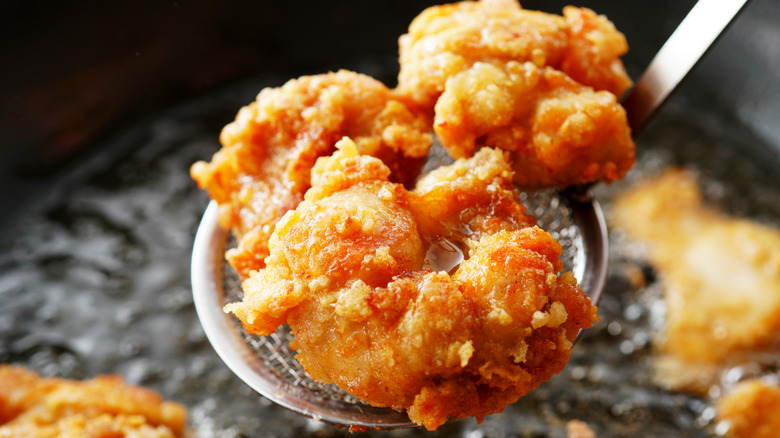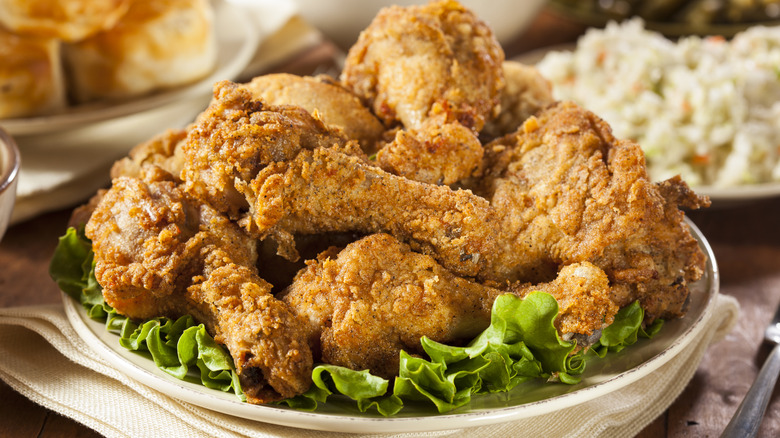What Is Japanese Karaage And How Does It Differ From American Fried Chicken?
Fried chicken might seem like comfort food — and to be clear, it absolutely is — but it's also a global phenomenon. You'll find it everywhere — from Southern cookouts to Japanese convenience stores (which are very different from the American kind) — and no matter where you try it, it's likely to be golden, crisped to utter perfection, and, most importantly, absurdly tasty.
What makes it so much fun, honestly, is how endlessly customizable it is. Some styles go big on crunch, layering in a whole spice cabinet's worth of flavor. Others really lean into lightness and textural nuance. You've got sweet glazes, spicy rubs, and a world of mouthwatering dipping sauces that live rent-free in your brain. It's a choose-your-own-adventure — and every ending is delicious.
If we're talking icons, though — and we are — it's hard to beat the one-two punch of American fried chicken and Japanese karaage. The American version comes in loud, with bold flavors and a crunch you can practically hear before you even take a bite. Karaage, however, is a bit more subtle in its approach — it's still perfectly seasoned, but marinated in a soy-and-ginger situation and fried just enough to stay delicate. Let's go ahead and break down what makes each style unique (but remember: There's no rule saying you can't cook up and enjoy both).
Karaage is delicate and stands on its own
Pronounced kah-rah-ah-geh, karaage is Japan's version of fried chicken — and it's everywhere. You'll find it in convenience stores (known as konbini), bento boxes, specialty karaage shops, and even packed into picnic baskets. It's juicy, punchy, and flavorful enough to make even the most loyal American fried chicken fans question their allegiances.
The magic starts with the marinade. Instead of getting dipped in buttermilk, karaage — which is usually made with bite-sized cuts of boneless, skinless chicken thigh — gets the full flavor treatment. It's dunked in a mixture of grated ginger, soy sauce, garlic, mirin, and sake (although recipe developer Kevin Chen swaps the mirin for vodka and adds powdered chicken bouillon and sesame oil to his double-fried karaage chicken) for up to 24 hours.
After marinating, the chicken typically gets coated in a light layer of potato starch (katakuriko), which gives it that signature crispiness — not as shatteringly loud as a kettle chip, but with just the right amount of delicate crunch. Then comes the frying, either once or twice, depending on the approach, but always done with care. The result? Golden, craggy, glistening bites of paradise.
Karaage is usually served just as it is. You might get a lemon wedge, or maybe a dab of Kewpie mayo, but that's about it. Karaage is confident. It doesn't need distractions — just a cold beer and maybe someone you love enough to share the last piece with.
American fried chicken is bold and crunchy
American fried chicken walks into the room like it owns the place — and to be fair, it sort of does. This is the extrovert of the fried poultry family: battered to high heaven, seasoned six ways from Sunday, and fried in piping hot oil to seal in the juiciness (and deliver that iconically crunchy bite).
To make American-style fried chicken (which uses all kinds of cuts — bone-in and boneless, wings, thighs, breasts, you name it), you typically dunk the pieces in a brine or buttermilk bath, preferably overnight. Then comes a generous dredge in a flour-and-spice mix before deep-frying it like your actual life depends on it. The result? A thick, crispy, and deeply savory crust. While there are similarities between Northern and Southern fried chicken, the Southern style leans a bit more into maximalism, and often features paprika, a splash of hot sauce, or a dash of cayenne for extra heat.
When it comes to sides, American fried chicken rarely shows up alone. It's often served with mac and cheese, creamed corn (bonus points if you make it with chives and chiles), french fries, or mashed potatoes. The dish is all about abundance and flavor.
So yes, karaage is refined and delicate. American fried chicken is loud and proud. They're not rivals — they're just different love languages. The best part is, you don't actually have to choose between them — you can absolutely fall in love with both.



